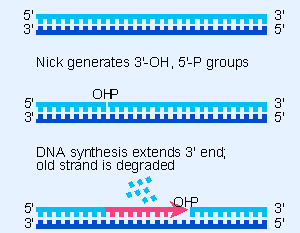3. DNA polymerases have various nuclease activities
13.3 DNA polymerases have various nuclease activities |
| Key terms defined in this section |
| Nick translation describes the ability of E. coli DNA polymerase I to use a nick as a starting point from which one strand of a duplex DNA can be degraded and replaced by resynthesis of new material; is used to introduce radioactively labeled nucleotides into DNA in vitro. |
DNA polymerases typically have nuclease activities as well as the ability to synthesize DNA. A 3′ V5′ exonuclease activity is typically used to excise bases that have been added to DNA incorrectly. This provides a "proofreading" error-control system, as we see in the next section.
The first enzyme to be characterized was DNA polymerase I, which is a single polypeptide of 103 kD. The chain can be cleaved into two regions by proteolytic treatment.
The larger cleavage product (68 kD) is called the Klenow fragment. It is used in synthetic reactions in vitro. It contains the polymerase and the 3′ V5′ exonuclease activities. The C-terminal two-thirds of the protein contains the polymerase active site, while the N-terminal third contains the proofreading exonuclease. The active sites are ~30 Å apart in the protein, indicating that there is spatial separation between adding a base and removing one.
The small fragment (35 kD) possesses a 5′ V3′ exonucleolytic activity, which excises small groups of nucleotides, up to ~10 bases at a time. This activity is coordinated with the synthetic/proofreading activity. It provides DNA polymerase I with a unique ability to start replication in vitro at a nick in DNA. (No other DNA polymerase has this ability.) At a point where a phosphodiester bond has been broken in a double-stranded DNA, the enzyme extends the 3′ VOH end. As the new segment of DNA is synthesized, it displaces the existing homologous strand in the duplex.
 |
Figure 13.5 Nick translation replaces part of a pre-existing strand of duplex DNA with newly synthesized material. |
This process of nick translation is illustrated in Figure 13.5. The displaced strand is degraded by the 5′ V3′ exonucleolytic activity of the enzyme. The properties of the DNA are unaltered, except that a segment of one strand has been replaced with newly synthesized material, and the position of the nick has been moved along the duplex. This is of great practical use; nick translation has been a major technique for introducing radioactively labeled nucleotides into DNA in vitro.
The 5′ V3′ synthetic/3′ V5′ exonucleolytic action is probably used in vivo mostly for filling in short single-stranded regions in double-stranded DNA. These regions arise during replication, and also when bases that have been damaged are removed from DNA (see 14 Recombination and repair).
DNA polymerase III (the replicase) is a large enzyme complex. The replicase activity was originally discovered by a lethal mutation in the dnaE locus, which codes for the 130 kD α subunit that possesses the DNA synthetic activity. The 3′ V5′ exonucleolytic proofreading activity is found in another subunit, ε, coded by dnaQ. The basic role of the ε subunit in controlling the fidelity of replication in vivo is demonstrated by the effect of mutations in dnaQ: the frequency with which mutations occur in the bacterial strain is increased by >103 Vfold.